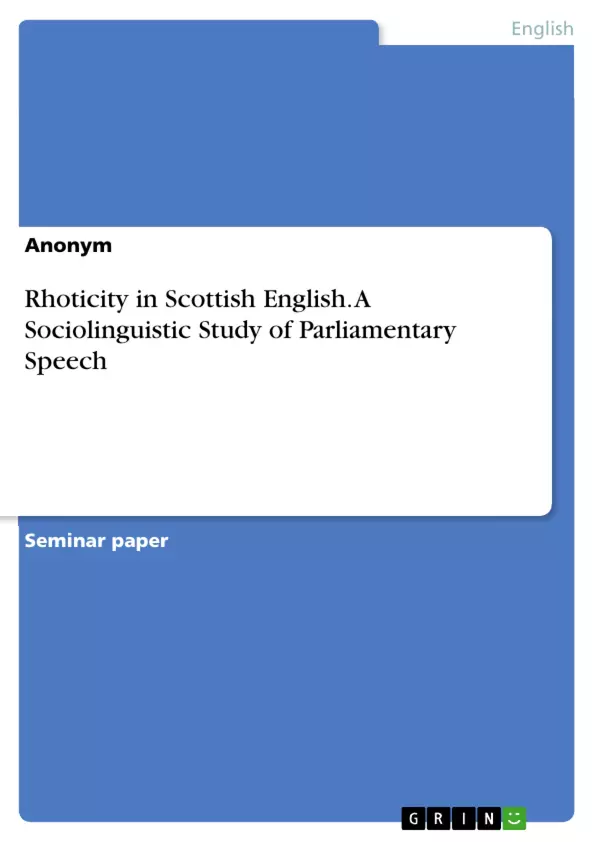In this paper, rhoticity in Scotland and gender differences in realization are in the focus. Particularly of interest is whether Scottish is proved to be mostly rhotic and whether there is a discrepancy between male and female speakers in rhoticity, as well as in type of realization. First, the theoretical background on the variable in question is provided and important existing studies on this topic introduced. Subsequently, methodological procedure and collection of the envelope of variation are explained. Finally, the results on rhoticity are displayed and discussed against the backdrop of similar findings giving insight into the language situation in Scotland.
Scottish English is a rather complex term describing the linguistic situation in Scotland Apart from Gaelic, which is considered a separate language, Scots and Standard Scottish English fall under the term Scottish English and include an array of varieties beginning with aforementioned SSE and ending with broad Scots. While the latter comprises several dialects varying from town to town, SSE can be seen as the standard variety of English in Scotland. In fact, Scots and Standard Scottish English function as "two opposite poles of a bipolar language continuum". According to Aitken’s model, speakers unconsciously shift between points on the continuum. However, Scots is usually spoken by the working class and amongst family and friends; SSE on the other hand is preferred by middle-class speakers and/or used for rather formal occasions. Boundaries between the two language plus Received Pronunciation, which only forms a small percentage of speakers, are overlapping and ambiguous.
As other varieties of English, Scottish English provides distinctive features, which are frequently used yet not always. Highest discrepancy with Received Pronunciation, which serves as the status quo, is the pronunciation. Alongside with the shortening of vowel length and th-fronting, rhoticity displays a marker for Scottish varieties. Akin to other languages, /r/ "is particularly variable and exhibits several phonetic realizations". This is the case in Scotland where rhotic consonants are "extremely variable"and in contrast to other varieties of English most commonly rhotic. The likelihood of a rhotic pronunciation is, though, dependant on social as well as intra-linguistic factors.
Table of Contents
- Introduction
- Theoretical background
- Methodology
- Results and Discussion
- Conclusion
- References
Objectives and Key Themes
This paper investigates rhoticity in Scottish English, specifically exploring whether the variety is predominantly rhotic and if there are gender differences in rhotic realization. It examines the theoretical background of rhoticity in Scottish English, including the historical and social factors influencing its pronunciation.
- Rhoticity as a key phonological characteristic of Scottish English
- The historical development of rhoticity in Scottish English compared to Received Pronunciation
- Social and linguistic factors influencing rhotic realization, including gender, socio-economic class, and contact with Standard Scottish English speakers
- The variation of /r/ allophones in Scottish English
- The relationship between rhoticity and the concept of prestige in Scottish society
Chapter Summaries
- Introduction: This chapter introduces the complex linguistic situation in Scotland, highlighting the interplay between Scots, Standard Scottish English (SSE), and Received Pronunciation. It emphasizes the significance of rhoticity as a distinctive feature of Scottish English, particularly in contrast to Received Pronunciation.
- Theoretical background: This chapter delves into the theoretical framework of rhoticity in Scottish English. It explores the historical and social factors contributing to the development of rhoticity, including the influence of language contact, prestige, and social class. The chapter also provides an overview of the different allophones of /r/ in Scottish speech, including their levels of rhoticity.
Keywords
The main keywords and focus topics of the text include rhoticity, Scottish English, Received Pronunciation, gender, socio-economic class, allophones, variation, prestige, and language contact. The study explores the interplay of these factors in shaping the pronunciation of /r/ in Scottish English.
- Quote paper
- Anonym (Author), 2021, Rhoticity in Scottish English. A Sociolinguistic Study of Parliamentary Speech, Munich, GRIN Verlag, https://www.hausarbeiten.de/document/1453378


